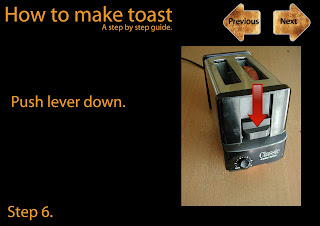- Plug toaster in at powerpoint.
- Remove bread from bag.
- Is the bread frozen? If so, defrost in microwave.
- Place bread slices into toaster slot.
- Adjust desired cooking time.
- Push lever down.
- When toast is released, check if properly cooked. If not, repeat step 6.
- Remove toast from toaster.
- Place toast on cutting board.
- Remove knife from drawer.
- Remove butter from fridge.
- Scrape butter using knife.
- Apply butter to toast.
- Apply favourite spread.
- Consume.
Flowchart
 (Click on image for full size)
(Click on image for full size)Storyboard



Moodboard
Moodboards allow us to create a theme for a project by recognising colours, textures, items, activities and other characteristics that a specific user might enjoy. These can then be incorporated into products/systems to allow the user to relate.















